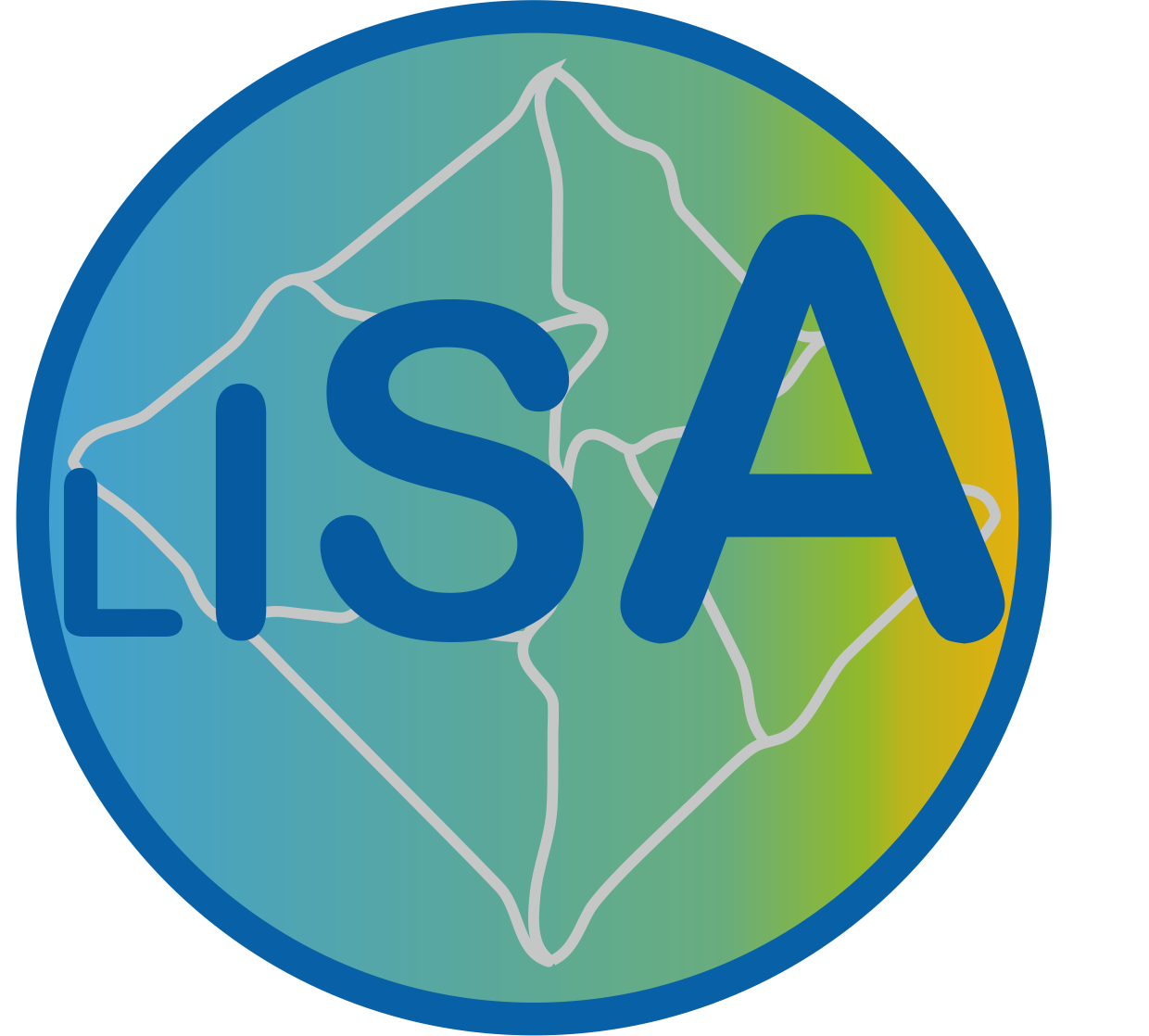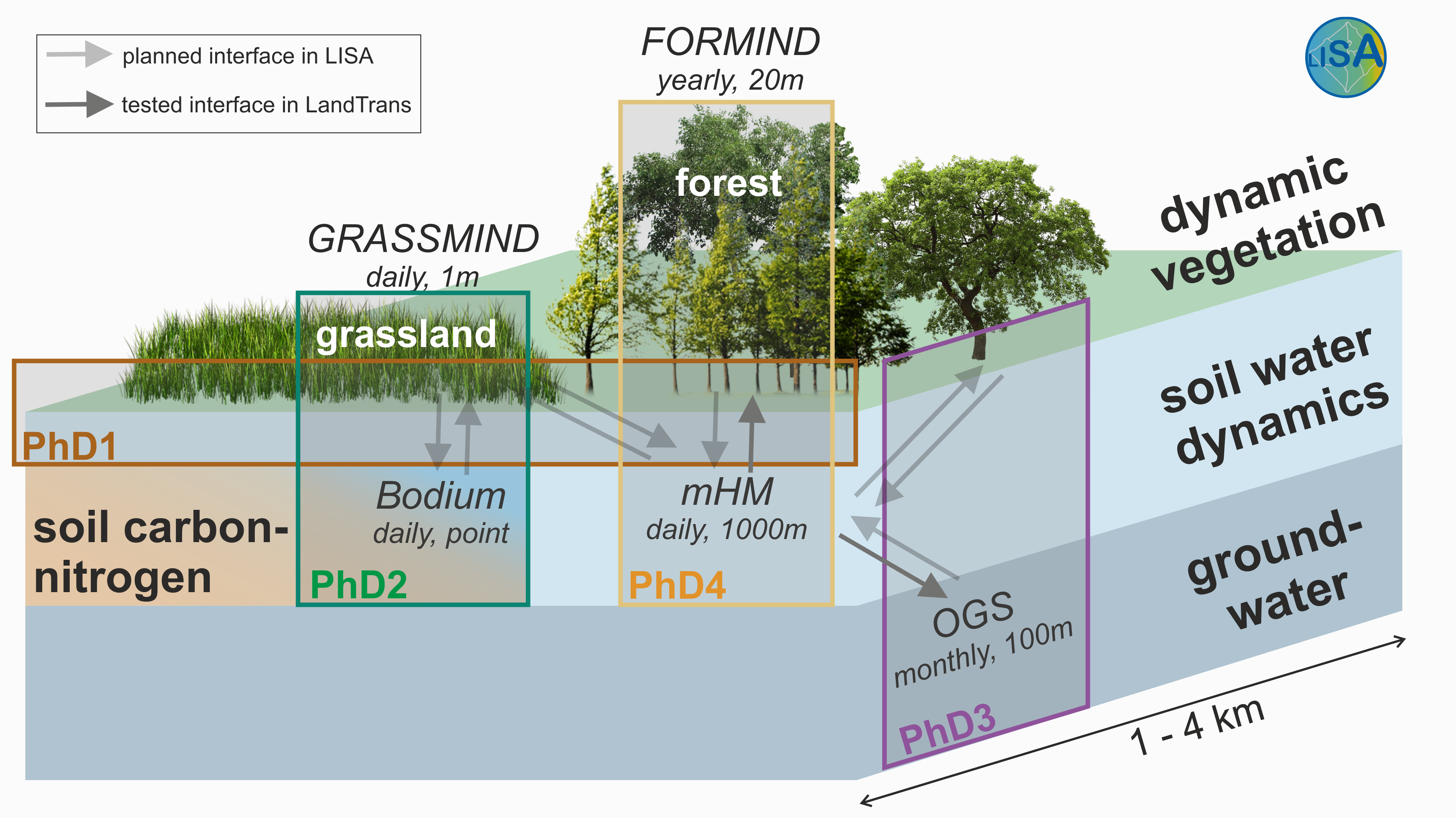PhD College LISA

The challenge to explore multifunctional landscapes in a model-based framework: model interfaces and scaling issues
The PhD Colleg LISA with 4 Phd positions is launched in 2023 in the Research Unit Smart Models / Monitoring. LISA is about exploring the multifunctionality of cultural landscapes in Germany and to examine the effects of climate change and land use in a model-based framework.
Climatic change and land-use pressure are expected to alter the dynamics of multifunctional landscapes and thus the regional carbon, nutrient and water cycle. However, the specific implications are uncertain, as there are numerous hidden feedbacks between ecosystems, the atmosphere and the subsurface. At the same time, reliable projections for multifunctional landscapes in transition are urgently needed to support decision making - for example, for the agricultural transition or the envisaged forest transformation to resilient forests. There are already a number of models available at the UFZ that can simulate individual components of multifunctional landscapes. However, an interactive coupling of these components (e.g. forest with soil water) has so far been missing which is envisaged to be developed in the model-based framework ‘LandTrans'. This new landscape model is developed in a truly interdisciplinary effort and explicitly considers the multifunctionality of landscapes.
The goal of the PhD college LISA is to create a consistent scaling framework for LandTrans by exploring model interfaces and providing a scientific basis for spatial and temporal scaling between the coupled models covering the water, carbon, and nutrient cycle and their parametrization at regional landscapes. For this purpose, the model interfaces and scaling strategies developed in LISA will be examined at various use-cases (i.e. demonstrator catchments).
LISA and LandTrans are projects in the Integration Platform “Robust Pictures of the Future” which aims to contribute to the provision of sustainable solutions for assuring multifunctionality in landscapes under climate change.

- FORMIND. FORMIND is an individual-based vegetation model that simulates the growth of species-rich forests on the hectare scale. Website.
- mHM. The mesoscale hydrologic model is a spatially explicit distributed hydrologic model that uses grid cells as a primary hydrologic unit. Website.
- GRASSMIND. GRASSMIND is an individual- and process-based grassland model designed for simulating the structure and dynamics of species-rich herbaceous communities (including management). Website.
- OGS. OpenGeoSys is a scientific, open-source project for the development of numerical methods for the simulation of thermo-hydro-mechanical-chemical processes in porous and fractured media.Website.
- BODIUM. The BODIUM model describes the dynamics of soil carbon-nitrogen and soil moisture. Website.
- FINAM. FINAM is a lighweight, easy to use model coupling framework. Written in Python, it can be used to link models written in virtually any language. Website.
Overview. The application of the LandTrans simulator to study land use and climate change impacts requires that all model components have been fully coupled beforehand and any scaling discrepancies be addressed. In LISA, we focus on the backbone of the simulator, e.g. model components that account for the carbon-, nitrogen- and water-cycles and on scaling issues related to their coupling: PhD1 investigates the coupling of vegetation components with the mHM model, PhD2 focuses on the coupling of GRASSMIND with BODIUM, PhD3 couples OGS with mHM, and PhD4 links FORMIND with mHM. Soil water dynamics being the common basis for all four PhD projects. To provide area-wide predictions of long-term landscape dynamics and to derive region-specific solutions for securing multifunctionality in landscapes, all model components of the overall system need to be integrated at the same scales. Therefore, joint scaling methods and a common validation strategy will be developed. Each of these model couplings will be parametrized and validated for demonstrator catchments.
Expected outcomes:
- scaling strategies and model interfaces between coupled models
- application of the LandTrans model framework to demonstrator catchments with a spatial resolution of 1-km and daily time steps
- concept and first tentative test for using the LandTrans model framework as biophysical component for socio-economic and socio-ecological models on farmer decisions
PhD1: Interfaces between hydrological models and vegetation models of varying complexity
PhD student: Carla Peter
Supervising team: Anke Hildebrandt, Franziska Taubert
Evapotranspiration (ET) is the second largest flux in the hydrologic cycle over land, and is strongly dominated by transpiration, that is the water loss suffered by plants during carbon uptake. In this way, evapotranspiration is an essential variable both in vegetation and hydrological models, as it connects the water and carbon cycles. However, currently the hydrological model mHM cannot account for the link between leaf area and transpiration, because ET in dry periods is only limited by soil moisture. Additionally, when several land-use types (potentially each with their own model) share a grid cell in a future coupled LandTrans simulator, the meso-scale aggregated ET depends also on the spatial variation of the leaf area within it. This subgrid variability can become substantial, depending on both vegetation dynamics and management, for example between harvested cropland and neighboring forest in late summer. Approaches for accounting for subgrid heterogeneity of vegetation types in land surface schemes, e.g. mosaic approaches, do exist in surface exchange models. However, scaling investigations regarding vegetation traditionally focused on the mixing in the atmosphere, and only recently have been addressed in hydrological models, and found to affect flux partitioning. Therefore, the goal of this PhD project is to implement and test a dedicated scaling and aggregation scheme for mixed vegetation types in a mesoscale grid cell by way of transfer functions. This will allow for mutually beneficial coupling between the modeled hydrological and vegetation dynamics. The same transfer function will also introduce reduction factors for evapotranspiration that depend on vegetation state and can be incorporated into a coupled model calibration.
PhD2: Modelling ecological and socio-economic impacts of grasslands
PhD student: Matthes Katzenbach
Supervising team: Franziska Taubert, Sara König
Almost 30% of Germany’s agricultural area is permanent grassland providing important ecosystem functions and services (e.g. biodiversity, fodder, carbon storage, cultural value). Quantity and quality is strongly determined by the local environment (e.g. soil and weather) and land use of farmers whose decisions may be influenced by policy instruments acting at larger spatial and temporal scales. Many studies have focused on the dynamics of a single component (e.g. plants, soil structure, water flows or farmer behavior) and simplified other components. To derive robust predictions on a sustainable development of grasslands across Germany, however, a comprehensive modeling framework is required which integrates the interactions and feedback between all components driving grassland dynamics.
In this project, we aim to develop such an interdisciplinary modeling framework first, by creating a biophysical model system that accounts for relevant vegetation-, soil- and hydrological processes, and second, by integrating output of the biophysical model system with socio-economic / socio-ecological agent-based models that address the impact of policy instruments on farmer decisions. More specifically, the biophysical model system will be achieved by coupling a grassland biodiversity model (GRASSMIND) and a soil model (BODIUM), which will be parametrized and validated for LandTrans demonstrator catchments in Germany. Simulated grassland yield will then be transferred to a socio-economic agent-based model (DroughtMAS) to evaluate the effect of different subsidies which can influence farmer decisions. Major challenges thereby include (1) to identify relevant interfaces for coupling the biophysical models and (2) to integrate subgrid heterogeneity of model parameters and drivers (soil type, management) at a larger spatial resolution of the LandTrans framework and of socio-economic/-ecological models. Upscaling of soil information has been already successfully implemented in mHM using MPR, which will be adopted for grasslands here.
PhD3: Groundwater recharge and soil moisture, two interacting key parameters at the interface between soil and groundwater hydrology
PhD student: Afid Nur Kholis
Supervising team: Thomas Kalbacher, Mariaines Di Dato
Groundwater recharge and soil moisture are both key variables within the water balance and their alteration not only directly impacts the hydrological cycle, but also significantly affects the carbon and nutrient cycles. Therefore, it is important to understand where and how their interplay is changing due to climate change and land use, and the implications of changing distribution and dynamics on water availability for humans and nature. Scenario analysis, which use the interconnected models that simulate parts of the hydrologic cycle (i.e., OGS, mHM, FORMIND) are needed to investigate this. Therefore, a new interface between these models is needed that allows feedback's in both directions, and is SMART in doing so. This will allow to summarize the influencing factors of each other's model across scales and transfer them back and forth between the models as effective quantities. Scaling through this interface is of great interest in two respects.
PhD4: Multifunctional assessment of forest ecosystems through model coupling
PhD student: Niklas Bruns
Supervising team: Samuel M. Fischer, Stephan Thober
Forests are of great importance for providing diverse ecosystem services (including timber, carbon sink, water, protection against land erosion). At the same time, they are affected by the climate crisis, with sometimes dramatic consequences: droughts and pest outbreaks have led to considerable forest damages in Germany in recent years. The expected worsening of the climate crisis is pushing the existing forest management to its limits and requires comprehensive adaptation. For a sustainable management of future forest landscapes, policy and decision makers need up-to-date information on forest development.
To investigate forest growth under climate change and extreme events, forest models such as the UFZ model FORMIND have been developed. However, the important soil water dynamics, which are crucial for tree growth, are only represented in a rather basic way in such models (one coarse soil layer, annual time steps). The water balance over larger areas is often neglected. In comparison, the UFZ hydrological model mHM simulates soil water dynamics with much more detail. However, mHM does not represent the dynamics and species diversity of forest ecosystems that substantially impact the resilience of these ecosystems to drought. The aim of this work is to develop an improved model framework that addresses the multifunctionality of forested landscapes by combining the strengths of FORMIND and mHM. This requires redefining the scaling issues and interfaces that currently limit the coupling of FORMIND and mHM (e.g. the possibility to run FORMIND at daily time steps, different temporal resolution in the representation of LAI).
Head of the consortium
Anke Hildebrandt, Thomas Kalbacher, Franziska Taubert, Stephan Thober
Consortium team
Niklas Bruns, Matthes Katzenbach, Afid Nur Kholis, Carla Peter
Friedrich Bohn, Daniel Doktor, Samuel M. Fischer, Thomas Fischer, Andreas Huth, Christian Klassert, Bernd Klauer, Sara König, Maximilian Lange, Ralf Merz, Birgit Müller, Sebastian Preidl, Oldrich Rakovec, Luis Samaniego, Christian Siebert, Hans-Jörg Vogel, Ulrike Werban, Steffen Zacharias
External advisors
Rico Fischer (Julius-Kühn-Institute (JKI) - Institute for Forest Protection), Anne Verhoef (University of Reading, UK), Miriam Coenders (Delft University of Technology, NL)
